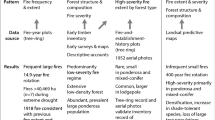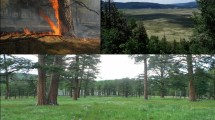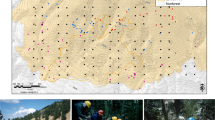Abstract
Context
In the interior Northwest, debate over restoring mixed-conifer forests after a century of fire exclusion is hampered by poor understanding of the pattern and causes of spatial variation in historical fire regimes.
Objectives
To identify the roles of topography, landscape structure, and forest type in driving spatial variation in historical fire regimes in mixed-conifer forests of central Oregon.
Methods
We used tree rings to reconstruct multicentury fire and forest histories at 105 plots over 10,393 ha. We classified fire regimes into four types and assessed whether they varied with topography, the location of fuel-limited pumice basins that inhibit fire spread, and an updated classification of forest type.
Results
We identified four fire-regime types and six forest types. Although surface fires were frequent and often extensive, severe fires were rare in all four types. Fire regimes varied with some aspects of topography (elevation), but not others (slope or aspect) and with the distribution of pumice basins. Fire regimes did not strictly co-vary with mixed-conifer forest types.
Conclusions
Our work reveals the persistent influence of landscape structure on spatial variation in historical fire regimes and can help inform discussions about appropriate restoration of fire-excluded forests in the interior Northwest. Where the goal is to restore historical fire regimes at landscape scales, managers may want to consider the influence of topoedaphic and vegetation patch types that could affect fire spread and ignition frequency.







Similar content being viewed by others
References
Agee JK (1993) Fire ecology of pacific northwest forests. Island Press, Washington, D.C
Agee JK, Wakimoto RH, Biswell HH (1978) Fire and fuel dynamics of Sierra Nevada conifers. For Ecol Manage 1:255–265
Applequist MB (1958) A simple pith locator for use with off-center increment cores. J Forest 56(2):141
Arabas KB, Hadley KS, Larson ER (2006) Fire history of a naturally fragmented landscape in central Oregon. Can J For Res 36:1108–1120
Arno SF, Sneck KM (1977) A method for determining fire history in coniferous forests of the mountain west. U.S. Forest Service General Technical Report GTR-INT-42
Baker WL (2012) Implications of spatially extensive historical data from surveys for restoring dry forests of Oregon’s eastern Cascades. Ecosphere 3(23):1–39
Baker WL (2015) Historical Northern spotted owl habitat and old-growth dry forests maintained by mixed-severity wildfires (2015). Landscape Ecol 30:655–666
Banwell EM, Varner MJ, Knapp EE, Van Kirk RW (2013) Spatial, seasonal, and diel forest floor moisture dynamics in Jeffrey pine-white fire forests of the Lake Tahoe Basin, USA. For Ecol Manag 305:11–20
Bartlein PJ, Hostetler SW, Shafer SL, Holman JO, Solomon AM (2008) Temporal and spatial structure in a daily wildfire-start data set from the western United States (1986–96). Int. J. Wildland Fire 17(1):8–17.
Beers TW, Dress PE, Wensel LC (1966) Aspect transformation in site productivity research. J For 64:691–692
Bergeron Y (1991) The influence of island and mainland lakeshore landscapes on boreal forest fire regimes. Ecology 72:1980–1992
Bolker BM, Brooks ME, Clark CJ, Geange SJ, Poulsen JR, Stevens MH, White JS (2009) Generalized linear mixed models: a practical guide for ecology and evolution. Trends Ecol Evol 24(3):127–135
Camp A, Oliver C, Hessburg P, Everett R (1997) Predicting late-successional fire refugia pre-dating European settlement in the Wenatchee Mountains. For Ecol Manag 95(1):63–77
de Magalhães RM, Schwilk DW (2012) Leaf traits and litter flammability: evidence for non-additive mixture effects in a temperate forest. J Ecol 100:1153–1163
Farris CA, Baisan CH, Falk DA, Yool SR, Swetnam TW (2010) Spatial and temporal corroboration of a fire-scar based fire history in a frequently burned ponderosa pine forest. Ecol Appl 20(6):1598–1614
Frost CC (2006) History and future of the longleaf pine ecosystem. In: Jose S, Jokela EJ, Miller DL (eds) The longleaf pine ecosystem—ecology, silviculture, and restoration. Springer, New York, pp 9–48
Gara R, Littke W, Agee J, Geiszler D, Stuart J, Driver C (1985) Influence of fires, fungi and mountain pine beetles on development of a lodgepole pine forest in south-central Oregon. In: Baumgartner DM et al (eds) Lodgepole pine: the species and its management Symposium Proceedings. Washington State University, Pullman, pp 153–162
Geist JM, Cochran PH (1991) Influences of volcanic ash and pumice deposition on productivity of wester interior forest soils. In: Harvey AE, Neuenschwander EH (eds) Proceedings: Management and Productivity of Western-Montane Forest Soils. USDA Forest Service Gen. Tech. Rep, Boise, Idaho. 10–12 April 1990INT-280:82.89
Geiszler DR, Gara RI, Driver CH, Gallucci VF, Martin RE (1980) Fire, fungi, and beetle influences on a lodgepole pine ecosystem of south-central Oregon. Oecologia 46:239–243
Hagmann KR, Franklin JF, Johnson KN (2013) Historical structure and composition of ponderosa pine and mixed-conifer forests in south-central Oregon. For Ecol Manage 304:492–504
Hagmann KR, Franklin JF, Johnson KN (2014) Historical conditions in mixed-conifer forests on the eastern slopes of the northern Oregon Cascade Range, USA. For Ecol Manage 330:158–170
Haugo R, Zanger C, DeMeo T, Ringo C, Shlisky A, Blankenship K, Simpson M, Mellen-McLean K, Kertis J, Stern M (2015) A new approach to evaluate forest structure restoration needs across Oregon and Washington, USA. For Ecol Manage 335:37–50
Hellberg E, Niklasson M, Granström A (2004) Influence of landscape structure on patterns of forest fires in boreal forest landscapes in Sweden. Can J For Res 34:332–338
Hessburg PF, Spies TA, Perry DA, Skinner CN, Taylor AH, Brown PM, Stephens SL, Larson AJ, Churchill DJ, Povak NA, Singleton PH, McComb B, Zielinski WJ, Collins BM, Salter RB, Keane JJ, Franklin JF, Riegel G (2016) Tamm review: management of mixed-severity fire regime forests in Oregon, Washington, and Northern California. For Ecol Manage 366:221–250
Heyerdahl EK, Brubaker LB, Agee JK (2001) Spatial controls of historical fire regimes: a multiscale example form the interior west, USA. Ecology 82(3):660–678
Heyerdahl EK, Falk DA, Loehman RA (2014a) Data archived with the International Multiproxy Paleofire Database, IGBP PAGES/World Data Center for Paleoclimatology. NOAA/NCDC Paleoclimatology Program, Boulder, Colorado, USA. https://www.ncdc.noaa.gov/paleo-search/study/23655
Heyerdahl EK, Loehman RA, Falk DA (2014b) Mixed-severity fire in lodgepole pine dominated forests: area historical regimes sustainable on Oregon’s Pumice Plateau, USA? Can J For Res 44:593–603
Holmes RL (1983) Program COFECHA User’s Manual. Laboratory of Tree-Ring Research, The University of Arizona, Tucson
Holsinger S, Parks SA, Miller C (2016) Weather, fuels and topography impede wildland fire spread in western US landscapes. For Ecol Manag 380:56–69
Howard JL, Aleksoff, KC (2000) Abies grandis. In: Fire Effects Information System, [Online]. U.S. Department of Agriculture, Forest Service, Rocky Mountain Research Station, Fire Sciences Laboratory (Producer). http://www.fs.fed.us/database/feis/plants/tree/abigra/all.html Accessed 22 Nov 2016
Johnston JD (2017) Forest succession along a productivity gradient following fire exclusion. For Ecol Manag 392:45–57
Johnston JD, Bailey JD, Dunn CJ (2016) Influence of fire disturbance and biophysical heterogeneity on pre-settlement ponderosa pine and mixed conifer forests. Ecosphere. https://doi.org/10.1002/ecs2.1581
Johnston JD, Bailey JD, Dunn CJ, Lindsay AA (2017) Historical fire-climate relationships in contrasting interior pacific northwest forest types. Fire Ecol 13(2):18–36
Jordan GJ, Fortin MJ, Lertzman KP (2008) Spatial pattern and persistence of historical fire boundaries in southern interior British Columbia. Environ Ecol Stat 15(4):523–535
Kellogg LB, McKenzie D, Peterson DL, Hessl A (2008) Spatial models for inferring topographic control son historical low-severity fire in the Eastern Cascade Range of Washington, USA. Landscape Ecol 23:227–240
Levine CR, Cogbill CV, Collins BM, Larson AJ, Lutz JA, North MP, Restaino CM, Safford HD, Stephens SL, Battles JJ (2017) Evaluating a new method for reconstructing forest conditions from General Land Office survey records. Ecol Appl 27(5):1498–1513
Lotan J, Brown J, Neuenschwander L (1985) Role of fire in lodgepole pine forests. In: Baumgartner D et al (eds) Lodgepole pine: the species and its management Symposium Proceedings. Washington State University, Pullman, pp 133–152
McCune B, Grace JB (2002) Analysis of ecological communities. J Exp Mar Biol Ecol 289(2)
McCune B, Mefford MJ (2010) PC-ORD. Multivariate Analysis of Ecological Data. Version 6.243 beta. MjM Software, Gleneden Beach, Oregon, USA
Merschel AG, Spies TA, Heyerdahl EK (2014) Mixed-conifer forests of central Oregon: effects of logging and fire exclusion vary with environment. Ecol Appl 24(7):1670–1688
Morgan P, Hardy CC, Swetnam TW, Rollins MG, Long DG (2001) Mapping fire regimes across time and space: understanding coarse and fine-scale fire patterns. Int J Wildl Fire 10(4):329–342
Morris MG (1934) Lightning Storms and Fires on the National Forests of Oregon and Washington. USDA Forest Service, Pacific Northwest Experiment Station, Portland, Oregon
Nielsen SE, DeLancy ER, Reinhardt K, Parisien M (2016) Effects of lakes on wildfire activity in the boreal forests of Saskatchewan, Canada. Forests. https://doi.org/10.3390/f7110265
Parks SA, Parisien SA, Miller C (2012) Spatial bottom–up controls on fire likelihood vary across western North America. Ecosphere 3(1):1–20
Perry DA, Jing DA, Youngblood A, Oetter DR (2004) Forest structure and fire susceptibility in volcanic landscapes of the Eastern High Cascades. Oregon. Conservation Biology 18(4):913926
PRISM Climate Group, Oregon State University. 2016. http://prism.oregonstate.edu
R Development Core Team (2008) R: A language and environment for statistical computing. R Foundation for Statistical Computing, Vienna, Austria. ISBN 3-900051-07-0, URL http://www.R-project.org
Rollins MG (2009) LANDFIRE: a nationally consistent vegetation, wildland fire, and fuel assessment. Int J Wildl Fire 18:235–249
Schoennagel TT, Veblen T, Romme WH (2004) The interaction of fire, fuels, and climate across rocky mountain forests. Bioscience 54(7):661–676
Simpson M (2007) Forested plant associations of the Oregon East Cascades. R6-NR-ECOL-TP-03-2007. USDA Forest Service, Pacific Northwest Region, USA
Spies TA, Hemstrom MA, Youngblood A, Hummel S (2006) Conserving old-growth forest diversity in disturbance-prone landscapes. Conserv Biol 20(2):351–362
Stevens JT, Safford HD, North MP, Fried JS, Gray AN, Brown PM, Dolanc CR, Dobrowski SZ, Falk DA, Farris CA, Franklin JF, Fulé PZ, Hagmann RK, Knapp EE, Miller JD, Smith DF, Swetnam TW, Taylor AH (2016) Average stand age from forest inventory plots does not describe historical fire regimes in ponderosa pine and mixed-conifer forests of western North America. PLoS ONE 11(5):e0147688
Stine P, Hessburg P, Spies T, Kramer M, Fettig CJ, Hansen A, Lehmkuhl J, O’Hara K, Polivka K, Singleton P, Charnley S, Merschel A, White R (2014) The Ecology of Moist Mixed-conifer Forests in Eastern Oregon and Washington: a Synthesis of the Relevant Biophysical Science and Implications for Future Land Management. PNW-GTR-897. USDA Forest Service, Portland, Oregon, USA. p. 254
Stuart JD, Agee JK, Gara R (1989) Lodgepole pine regeneration in an old, self-perpetuating forest in south central Oregon. Can J Forest Res 19:1096–1104
Sugihara NG, van Wagtenkdonk JW, Shaffer KE, Fites-Kaufman J, Thode AE (2006) Fire in California’s Ecosystems. University of California Press, Berkeley
Swetnam TW, Wickman BE, Paul HG, Baisan CH (1995) Historical patterns of western spruce budworm and Douglas-fir tussock moth outbreaks in the northern Blue Mountains, Oregon since A.D. 1700. GTR-PNW-484. USDA Forest Service, Portland, Oregon, USA
Taylor AH, Skinner CN (2003) Spatial patterns and controls on historical fire regimes and forest structure in the Klamath mountains. Ecol Appl 13(3):704–719
van Wagtendonk JW (1993) Spatial patterns of lightning strikes and fires in Yosemite National Park. In: Proceedings 12th Conference on Fire and Forest Meteorology, vol 12, pp. 223–231
Vogt BJ, Hodanish SJ (2014) A high-resolution lightning map of the state of Colorado. Mon Weather Rev 142:2353–2360
Volland AL (1985) Plant associations of the central Oregon pumice zone. R6 Ecol 104-1985. Portland OR: U.S. Department of Agriculture, Forest Service, Pacific Northwest Region. 138 p
Wright CS, Agee JK (2004) Fire and vegetation history in the eastern cascade mountains, Washington. Ecol Appl 14(2):443–459
Acknowledgements
We thank Meg Krawchuk, Don Falk, Matt Reilly, Emily Comfort, and two anonymous reviews for comments on earlier drafts. This work was facilitated through the Nature Conservancy, Deschutes National Forest, and the Deschutes Collaborative Forest Project. Funding was provided by the Oregon Department of Forestry, the Deschutes National Forest, and the USFS Pacific Northwest Research Station. We thank Pete Caligiuri and Mark Stern for their assistance in coordinating and implementing the project. We thank Pete Powers for his summary of management history in the study area. We thank Calvin Farris for his methodological assistance with mapping historical fires, and Chris Zanger, Keith Olsen, and Ray Davis for help with GIS work. We thank Abby Eurich, Brent Gaither, Kelly Regan, James Johnston, Kayla Johnston, Dawn Pepper, Ben Hart, Lauren Matoszuik, Andrés Holz, Bobby Burdick, and Beatrice Serrano-Martinez for assistance in the field and with dendrochronological work.
Author information
Authors and Affiliations
Corresponding author
Electronic supplementary material
Below is the link to the electronic supplementary material.
Rights and permissions
About this article
Cite this article
Merschel, A.G., Heyerdahl, E.K., Spies, T.A. et al. Influence of landscape structure, topography, and forest type on spatial variation in historical fire regimes, Central Oregon, USA. Landscape Ecol 33, 1195–1209 (2018). https://doi.org/10.1007/s10980-018-0656-6
Received:
Accepted:
Published:
Issue Date:
DOI: https://doi.org/10.1007/s10980-018-0656-6




